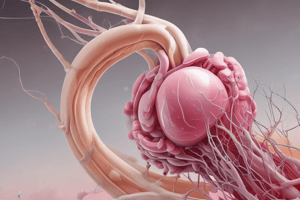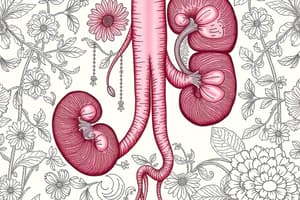Podcast
Questions and Answers
What is oliguria defined as?
What is oliguria defined as?
- Urine output of exactly 1 liter per day
- Urine output of less than 400 mL per day (correct)
- Urine output that fluctuates daily
- Urine output of more than 400 mL per day
Which of the following is NOT a consequence of chronic kidney disease?
Which of the following is NOT a consequence of chronic kidney disease?
- Altered calcium and phosphate metabolism
- Increased plasma creatinine levels
- Retained potassium
- Enhanced erythropoietin production (correct)
Which mechanism contributes to the progression of chronic kidney disease?
Which mechanism contributes to the progression of chronic kidney disease?
- Decreased fluid intake
- Increased sodium reabsorption
- Glomerular hypertension (correct)
- Hyperfiltration in the gastrointestinal tract
What characterizes uremic syndrome in chronic kidney failure?
What characterizes uremic syndrome in chronic kidney failure?
At what point do symptomatic changes typically become evident in chronic kidney disease?
At what point do symptomatic changes typically become evident in chronic kidney disease?
What characterizes uncomplicated urinary tract infections (UTIs)?
What characterizes uncomplicated urinary tract infections (UTIs)?
Which host defense mechanism helps prevent urinary tract infections?
Which host defense mechanism helps prevent urinary tract infections?
What is a common cause of cystitis?
What is a common cause of cystitis?
What is the role of pili or fimbriae in virulent uropathogens?
What is the role of pili or fimbriae in virulent uropathogens?
What sediment pattern is associated with nephritic syndrome during urine examination?
What sediment pattern is associated with nephritic syndrome during urine examination?
Which of the following correctly describes acute postinfectious glomerulonephritis?
Which of the following correctly describes acute postinfectious glomerulonephritis?
Which condition is characterized by autoantibodies against double-stranded DNA?
Which condition is characterized by autoantibodies against double-stranded DNA?
What is the primary consequence of inflammation in the urinary system?
What is the primary consequence of inflammation in the urinary system?
What is the most common type of kidney stone that typically causes obstruction?
What is the most common type of kidney stone that typically causes obstruction?
Which of the following is a direct consequence of untreated obstructive uropathy?
Which of the following is a direct consequence of untreated obstructive uropathy?
Obstruction of the bladder may be caused by which of the following?
Obstruction of the bladder may be caused by which of the following?
Which factor is NOT a common cause of urinary tract obstruction?
Which factor is NOT a common cause of urinary tract obstruction?
What occurs as a compensatory mechanism in response to obstructive disease in one kidney?
What occurs as a compensatory mechanism in response to obstructive disease in one kidney?
Which neurological condition results in detrusor sphincter dyssynergia?
Which neurological condition results in detrusor sphincter dyssynergia?
What is a potential complication of urinary tract obstruction caused by urinary accumulation?
What is a potential complication of urinary tract obstruction caused by urinary accumulation?
What characterizes overactive bladder (OAB) syndrome?
What characterizes overactive bladder (OAB) syndrome?
What defines focal segmental glomerulosclerosis?
What defines focal segmental glomerulosclerosis?
What is the primary cause of diabetic nephropathy?
What is the primary cause of diabetic nephropathy?
Which condition is characterized by hematuria and less severe proteinuria?
Which condition is characterized by hematuria and less severe proteinuria?
What is the mechanism of injury in membranous nephropathy?
What is the mechanism of injury in membranous nephropathy?
Which situation typically causes intrarenal acute renal failure?
Which situation typically causes intrarenal acute renal failure?
What are the principal signs of nephrotic syndrome?
What are the principal signs of nephrotic syndrome?
Which statement about AKI is true?
Which statement about AKI is true?
What is typically associated with mesangial proliferative glomerulonephritis?
What is typically associated with mesangial proliferative glomerulonephritis?
Flashcards
Hydronephrosis
Hydronephrosis
A condition where urine backs up and causes the kidneys to swell.
Hydroureter
Hydroureter
A condition where urine backs up and causes the ureter to swell.
Ureterohydronephrosis
Ureterohydronephrosis
A condition where urine backs up and causes both the kidneys and the ureters to swell.
Neurogenic bladder
Neurogenic bladder
Signup and view all the flashcards
Overactive bladder (OAB)
Overactive bladder (OAB)
Signup and view all the flashcards
Detrusor areflexia
Detrusor areflexia
Signup and view all the flashcards
Renal cell carcinoma
Renal cell carcinoma
Signup and view all the flashcards
Kidney stones
Kidney stones
Signup and view all the flashcards
What causes a UTI?
What causes a UTI?
Signup and view all the flashcards
What's the difference between an uncomplicated and complicated UTI?
What's the difference between an uncomplicated and complicated UTI?
Signup and view all the flashcards
What are some host defenses against UTIs?
What are some host defenses against UTIs?
Signup and view all the flashcards
How do virulent bacteria contribute to UTIs?
How do virulent bacteria contribute to UTIs?
Signup and view all the flashcards
How do biofilms influence UTIs?
How do biofilms influence UTIs?
Signup and view all the flashcards
What is cystitis?
What is cystitis?
Signup and view all the flashcards
What are the typical symptoms of cystitis?
What are the typical symptoms of cystitis?
Signup and view all the flashcards
What is interstitial cystitis/painful bladder syndrome?
What is interstitial cystitis/painful bladder syndrome?
Signup and view all the flashcards
IgA Nephropathy
IgA Nephropathy
Signup and view all the flashcards
Focal Segmental Glomerulosclerosis
Focal Segmental Glomerulosclerosis
Signup and view all the flashcards
Membranous Nephropathy
Membranous Nephropathy
Signup and view all the flashcards
Rapidly Progressive Glomerulonephritis (RPGN)
Rapidly Progressive Glomerulonephritis (RPGN)
Signup and view all the flashcards
Mesangial Proliferative Glomerulonephritis
Mesangial Proliferative Glomerulonephritis
Signup and view all the flashcards
Membranoproliferative Glomerulonephritis
Membranoproliferative Glomerulonephritis
Signup and view all the flashcards
Chronic Glomerulonephritis
Chronic Glomerulonephritis
Signup and view all the flashcards
Diabetic Nephropathy
Diabetic Nephropathy
Signup and view all the flashcards
Oliguria
Oliguria
Signup and view all the flashcards
Chronic Kidney Disease (CKD)
Chronic Kidney Disease (CKD)
Signup and view all the flashcards
Uremic Syndrome
Uremic Syndrome
Signup and view all the flashcards
Glomerular Hypertension, Hyperfiltration, and Inflammation
Glomerular Hypertension, Hyperfiltration, and Inflammation
Signup and view all the flashcards
Proteinuria and Angiotensin II
Proteinuria and Angiotensin II
Signup and view all the flashcards
Study Notes
Urinary Tract Obstruction
- Obstruction can affect any part of the urinary tract, including the kidneys, ureters, or urethra.
- Causes include kidney stones, tumors, enlarged prostate, or ureter/urethral strictures.
- Serious complications include hydronephrosis, hydroureter, uretero-hydronephrosis, and infection.
- Tubulointerstitial fibrosis and apoptosis can lead to chronic kidney disease.
- The opposite kidney often hypertrophies and overworks to compensate.
- Post-obstructive diuresis and electrolyte imbalances can follow obstruction.
- Kidney stones are often due to calcium oxalate, urine supersaturation, changes in urine pH, or infection.
Upper Motor Neuron Lesions
- C2 to S1 lesions lead to an overactive bladder, or hyperreflexive bladder function, and detrusor sphincter dys-synergia (lack of coordinated muscle contraction).
Lower Motor Neuron Lesions
- Below S1 lead to an underactive, hypotonic, or atonic bladder (detrusor areflexia).
Overactive Bladder (OAB) Syndrome
- Characterized by an uncontrollable or premature bladder contraction.
- Symptoms include urgency, frequency, and nocturia (nighttime urination).
Anatomic Obstructions
- Prostatic enlargement, urethral strictures, and pelvic organ prolapse (women) can obstruct urine flow.
- Partial bladder obstruction causes overactive bladder contractions and urgency.
- Collagen buildup in bladder wall can reduce compliance and detrusor muscle contraction effectiveness.
Renal Cell Carcinoma
- Most frequent renal neoplasm (tumor).
- Larger tumors tend to metastasize to lung, liver, and bone.
Bladder Tumors
- Composed primarily of transitional cells.
- Often have a papillary appearance.
- High recurrence rate is common.
Urinary Tract Infection (UTI)
- UTIs result from bacteria entering the urethra and bladder (retrograde movement).
- Uncomplicated UTIs occur in normally functioning urinary systems.
- Complicated UTIs arise from urinary system abnormalities.
- Host defenses like high urine osmolality, acidic pH, mucus, uromodulin, protect against UTIs.
Glomerular Diseases
- Glomerulonephritis involves inflammation of the glomerulus (filtering unit of the kidney).
- Causes include immune injury, infection, ischemia, toxins, drugs, or vascular disorders.
- Can be primary or secondary to systemic diseases.
- Acute glomerulonephritis: Often follows streptococcal infections.
- Lupus nephritis: Results from antibodies against double-stranded DNA (dsDNA) and nucleosomes.
- IgA nephropathy: Abnormal IgA binds to mesangial cells in the glomerulus.
- Focal segmental glomerulosclerosis: Scarring of some glomeruli.
- Membranous nephropathy: Antibody-mediated glomerular injury.
- RPGN: Rapidly progressing glomerulonephritis.
- Mesangial proliferative GN: Idiopathic, with immune complex deposits.
- Membranoproliferative GN: Mesangial cell proliferation, complement deposition, and crescent formation.
- Chronic glomerulonephritis: Gradual loss of renal function due to various diseases (e.g., diabetes, lupus).
Chronic Kidney Disease
- Progressive loss of kidney function.
- Elevated creatinine levels reflect decreased glomerular filtration rate (GFR).
- Symptoms become apparent as kidney function declines significantly.
- Glomerular hypertension, hyperfiltration, inflammation, and fibrosis contribute to progression.
- Patients develop uremic syndrome (buildup of toxins).
Studying That Suits You
Use AI to generate personalized quizzes and flashcards to suit your learning preferences.




